Roby Sweet's Blog, page 75
July 3, 2015
How Long Did It Take for a Saber-Toothed Cat to Grow Its Saber Teeth?
We are reaching deep into feline history today, all the way back to the Pleistocene epoch (2.5 million to 11,500 years ago, give or take), to learn something about our long-lost cousin the saber-toothed cat (that’s Smilodon fatalis if you want to be scientific). Why? Well, because, thanks to a new study, we now know how long it took these animals to grow their huge canine teeth, and we think that's pretty interesting.
 Here, kitty kitty—not!
Here, kitty kitty—not! Saber-toothedcat illustration on signage at the
Cincinnati Museum of Natural History & Science,
Cincinnati, Ohio.
Photo by James St. John
[CC BY 2.0], via Wikimedia Commons. A bit about the saber-toothed catSaber-toothed cats lived in North America and parts of South America until they went extinct 13,000 years ago. They probably weighed from 350 pounds to just over 600 pounds and stood nearly 40 inches tall at the shoulder. Oh, and those teeth we’re so interested in could be seven inches long and were serrated on both edges. (This is not a cat you’d want to have napping on your couch.)
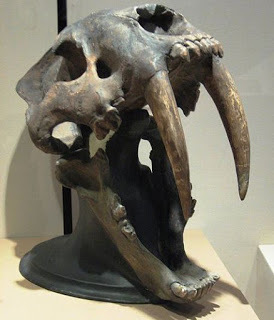 Saber-tooth cat skull at the
Saber-tooth cat skull at the Regional Museum of Guadalajara
in Guadalajara, Mexico.
Photo by Thelmadatter (Own work)
[Public domain], via Wikimedia Commons. Growing those saber teethPerhaps not surprisingly, it took a while for those big canine teeth to fully erupt, or push through the gums. According to a brand-new study using fossils from Rancho La Brea in southern California, permanent canine teeth began to erupt when saber-tooth cubs were between one and one and a half years old. The teeth erupted at about six millimeters (just under a quarter of an inch) per month, faster than the rate for modern lions, and a little more than half as fast as human hair grows.
At that rate, the saber teeth weren't fully erupted and at full size until the cats were about three years old.
To give you a little perspective, modern domestic cats have all their adult teeth ready to go when they’re about six months old.
Baby canines and adult sabers side by sideThe saber-tooth’s baby (or deciduous) canines finished erupting when the cat was about a year to a year and half old (the same time the adult sabers began to erupt). Then, as the permanent saber teeth erupted, the baby teeth remained in place for almost a year, possibly to keep the saber teeth from being broken.
Young saber-tooth cubs rare at Rancho La BreaUsing the tooth data to estimate ages of saber-toothed cats found at Rancho La Brea, the researchers found that cubs under four to seven months old were rarely preserved there. This makes sense when you consider that those younger cubs wouldn’t have had fully erupted baby canine teeth yet. Until they were well-equipped for defense, the cubs were probably kept closer to the den to keep them away from predators.
For more on prehistoric cats, see Meet the Cat of All Cats: He's 25 Million Years Old.
SourcesWysocki MA, Feranec RS, Tseng ZJ, Bjornsson CS (2015) Using a Novel Absolute Ontogenetic Age Determination Technique to Calculate the Timing of Tooth Eruption in the Saber-Toothed Cat, Smilodon fatalis. PLoS ONE 10(7): e0129847.
Saber-Toothed Cat Fact Sheet, San Diego Zoo. http://library.sandiegozoo.org/factsheets/_extinct/smilodon/smilodon.htm
Published on July 03, 2015 02:30
July 1, 2015
Medieval Cats Rock!: A Selection of 14th-Century Cats Playing Musical Instruments
Wordless Wednesday
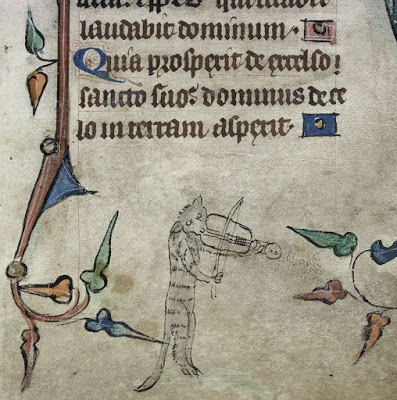 Cat Playing Rebec (detail)From a Book of Hours, London, c. 1320–1330.A rebec was a pear-shaped, usually three-stringed instrument
Cat Playing Rebec (detail)From a Book of Hours, London, c. 1320–1330.A rebec was a pear-shaped, usually three-stringed instrument
with a slender neck. It was played with a bow, just as the cat
is doing in the illustration.Public Domain, via the
British Library Catalogue of Illuminated Manuscripts .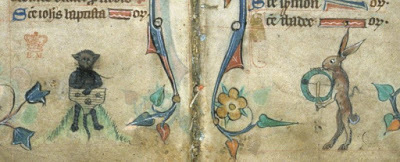 Cat Playing Instrument (detail)Marginal illustration from a Book of Hours.
Cat Playing Instrument (detail)Marginal illustration from a Book of Hours.
London, c. 1320–1330.On the left, a cat plays an unidentified instrument, while on the
right, a rabbit beats a drum.Public Domain, via the
British Library Catalogue of Illuminated Manuscripts .
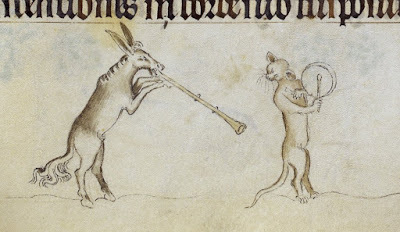 Cat Playing Tabor (detail)From “The Queen Mary Psalter,” attributed to
Cat Playing Tabor (detail)From “The Queen Mary Psalter,” attributed to
the Queen Mary Master.England, c. 1310-1320.A cat beats a tabor while a donkey plays a trumpet.A tabor was a small drum played as accompaniment to a
pipe or fife. The pipe and drum were both played by the same
musician, and you can just make out what appears to be a pipe
in the cat’s left paw.
Public Domain, via the
British Library Catalogue of Illuminated Manuscripts .
 Cat Playing Rebec (detail)From a Book of Hours, London, c. 1320–1330.A rebec was a pear-shaped, usually three-stringed instrument
Cat Playing Rebec (detail)From a Book of Hours, London, c. 1320–1330.A rebec was a pear-shaped, usually three-stringed instrument with a slender neck. It was played with a bow, just as the cat
is doing in the illustration.Public Domain, via the
British Library Catalogue of Illuminated Manuscripts .
 Cat Playing Instrument (detail)Marginal illustration from a Book of Hours.
Cat Playing Instrument (detail)Marginal illustration from a Book of Hours.London, c. 1320–1330.On the left, a cat plays an unidentified instrument, while on the
right, a rabbit beats a drum.Public Domain, via the
British Library Catalogue of Illuminated Manuscripts .
 Cat Playing Tabor (detail)From “The Queen Mary Psalter,” attributed to
Cat Playing Tabor (detail)From “The Queen Mary Psalter,” attributed to the Queen Mary Master.England, c. 1310-1320.A cat beats a tabor while a donkey plays a trumpet.A tabor was a small drum played as accompaniment to a
pipe or fife. The pipe and drum were both played by the same
musician, and you can just make out what appears to be a pipe
in the cat’s left paw.
Public Domain, via the
British Library Catalogue of Illuminated Manuscripts .
Published on July 01, 2015 02:30
June 29, 2015
Book Review: Downton Tabby
Miss Cuddlywumps reads the latest in the Pampered Pets series from Sparkle Abbey
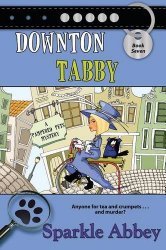

Carolina Lamont, or “Caro,” as she prefers to be called, has an interesting life. She’s a lovely redhead who drives a silver Mercedes roadster, a former Texas beauty queen, and though she trained as a people therapist, she’s now Laguna Beach’s top pet therapist. Oh, and she’s also the kind of person who has a homicide detective’s phone number in her favorites.
She has to. Because stuff keeps happening.
Caro shares office space with a realtor, a psychic (who says vaguely unsettling things like “I sense trouble” and “Beware of strangers”), an investment advisor, and two young techie types named Cash and Jake. The techies will be the ones causing trouble in this episode.
It all starts one unfortunate morning when Caro begins her day without coffee. Soon enough, one of the techies, Cash, has popped into her office quite pleasantly to ask her to watch his Scottish fold cat while he runs back home for “a jiffy.” Naturally he doesn’t come back, and Caro decides to drop Toria (the cat) off at home (Cash and Jake’s home) so she can get to an appointment on time. But when she gets to their house she discovers Jake dead in the pool, and there is no sign of Cash.
See what happens when you miss your morning coffee?
Soon Caro is thoroughly mixed up in a murder investigation, she’s being tailed by a dark-colored SUV, and her ex-husband is intruding most unpleasantly on her life. This while she’s taking care of poor Toria as well as her own dog and cats and practicing therapy on her clients…er, I mean on her clients’ pets.
And soon we’re worried over Caro’s safety.
I won’t tell you any more of the plot in this highly readable, quickly paced cozy. You really should read it for yourself, if for no other reason than to read the part where Caro finally gives her ex exactly what he deserves. But then you’ll also want to find out what’s up with this Cash character (innIt’s quite a story! Highly recommended!


Published on June 29, 2015 04:38
June 26, 2015
A Dispatch from Social Science: Cat Videos Make People Happy
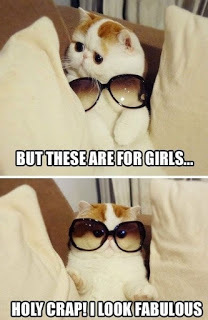 It's not just videos!
It's not just videos! Stills count too.It has finally happened. Social science has discovered Internet cat videos.
Well, I say “discovered,” but what I mean is “taken enough of an interest in to create a survey, the results of which were analyzed for insights into the Internet cat phenomenon” (“discovered” is just so much easier to say). This study, by Dr. Jessica Gall Myrick of Indiana University, appears in the most recent edition of the journal Computers in Human Behavior . In case you don’t subscribe to that one, I summarize the important points below.
Why study Internet cats?First, that is kind of a dumb question. Obviously, cat-related content is the best thing the Internet has to offer.
The researcher did have a more scientific reason, though: to find out what sort of people look at Internet cats, why they do so, and how the experience affects them emotionally.
The supposition is that people might go online to find some cute cat stuff to either lift their spirits if they’re feeling down or keep their spirits up if they’re already happy. Myrick sought to see if this idea is true.
What exactly did the study, study?With some help from Lil BUB, the study used on online survey that people responded to voluntarily. The survey asked questions about the respondents’ pets, their own personality and well-being, and their Internet cat viewing habits. It also asked how people felt before and after viewing an Internet cat.
Who goes gaga over Internet cats?What sort of people look at Internet cats? Well, of the 6,795 respondents in this study, 88% were female, 90% were white, and their average age was 38.74 years.
So, if you chuckle and/or squee over cute cat videos, odds are you’re a thirty-something white woman.
Why do people seek out online cat content?Actually, most of the time they don’t seek it out (or so they say). Cat content seeks them out.
Respondents reported they only went looking for Internet cats about a quarter of the time; mostly they “happened upon it accidentally” while on the Internet for something else (checking the Twitter feed on which they follow 451 different cat-related accounts, perhaps? Not that there’s anything wrong with that—that’s exactly how She of Little Talent gets her near-daily cute-cat fix).
How do Internet cats affect people’s emotions?Respondents said they felt more hopeful, happy, and content after viewing Internet cats. They also felt less anxious, annoyed, or sad, and they had more energy. They did feel a little guilty if they were online wasting time instead of doing whatever they were supposed to be doing (working), but the cats made them so happy they didn’t care. Basically.
The takeawayMore research can certainly be done on the relationship between Internet cats and human happiness. However, we will go out on a limb and say this:
Try an Internet cat today:Feel happier, more energetic, and less guilty!*
(*The study and its author have in no way endorsed this statement. We totally made it up.)
Now, please enjoy this Lil BUB video:
Published on June 26, 2015 02:30
June 24, 2015
A Pair of Modern Swedish Cats--in Sculpture
Wordless Wednesday
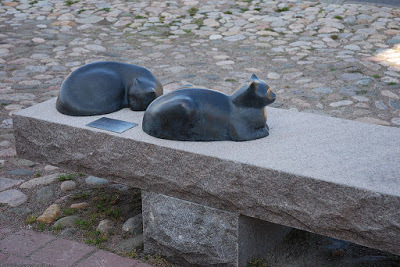 Bronze and granite sculpture titled “Trygghet”(Safety, Security) features a pair of very secure-looking cats.Art by Swedish sculptors Gustav and Ulla Kraitz.Höganäs, Sweden, 2005.Photo be Bengt Oberger[CC BY 3.0 (http://creativecommons.org/licenses/b... Wikimedia Commons.
Bronze and granite sculpture titled “Trygghet”(Safety, Security) features a pair of very secure-looking cats.Art by Swedish sculptors Gustav and Ulla Kraitz.Höganäs, Sweden, 2005.Photo be Bengt Oberger[CC BY 3.0 (http://creativecommons.org/licenses/b... Wikimedia Commons.
 Bronze and granite sculpture titled “Trygghet”(Safety, Security) features a pair of very secure-looking cats.Art by Swedish sculptors Gustav and Ulla Kraitz.Höganäs, Sweden, 2005.Photo be Bengt Oberger[CC BY 3.0 (http://creativecommons.org/licenses/b... Wikimedia Commons.
Bronze and granite sculpture titled “Trygghet”(Safety, Security) features a pair of very secure-looking cats.Art by Swedish sculptors Gustav and Ulla Kraitz.Höganäs, Sweden, 2005.Photo be Bengt Oberger[CC BY 3.0 (http://creativecommons.org/licenses/b... Wikimedia Commons.
Published on June 24, 2015 02:30
June 19, 2015
In Your Dreams! Interpretations of Dreams About Cats
Miss C investigates dream cats
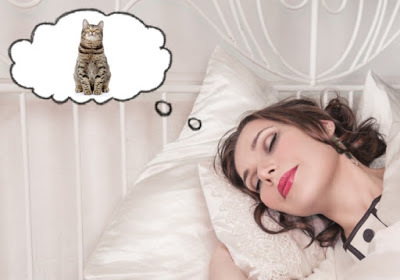 Seeing cats in your dreams?Could mean good luck—or something entirely different.Photo credits:Woman dreaming © Darkbird77 | Dreamstime.com -Beautiful Plus Size Woman Dreaming About Something PhotoCat © Photodeti | Dreamstime.com -Cat Sitting In Front And Looking Up. Isolated On White Backgroun Photo
Seeing cats in your dreams?Could mean good luck—or something entirely different.Photo credits:Woman dreaming © Darkbird77 | Dreamstime.com -Beautiful Plus Size Woman Dreaming About Something PhotoCat © Photodeti | Dreamstime.com -Cat Sitting In Front And Looking Up. Isolated On White Backgroun Photo
Have you ever wondered what it means when you dream about a cat, or if it means anything at all? Well, you are not alone. People have been trying to interpret their nocturnal encounters with dream cats for about four thousand years, and probably longer.
Ancient Egyptian cat-dream interpretationThe ancient Egyptians, whom we know held the cat in special regard, were (at least as far as we know) the first to consider the meaning of cats in dreams. Jaromir Malek, in The Cat in Ancient Egypt, wrote of an early dream-interpretation text dated to about 1980–1801 BC. According to this text, if a man saw a large cat (that’s mii oa if you’re talking like an Egyptian) in a dream, it was a good omen, as it meant he would have a large harvest (p. 79). Presumably that large cat would keep vermin from destroying the crop.
Modern cat-dream interpretationA lot of years have passed between 1980 BC and today, so I sent She of Little Talent to search out some modern views on dream interpretation. It turns out there are many, and none of them have anything to do with a large harvest.
A century ago, Sigmund Freud thought that dreams were all about wish fulfillment, but (in adults, at any rate) the true meanings were distorted so the dreamer didn’t recognize them. Carl Jung theorized that dreams could be much more, tapping into both a personal and a collective unconscious. In either system of interpretation, things in dreams can be symbols of something else—or not (sometimes a cat is just a cat, to paraphrase something Freud may or may not have said).
Assuming dream objects can be symbols, what do cats symbolize? Well, old SoLT’s research turned up the following interpretations of what dream cats represent:
Illusions, delusions, false or irrational beliefs, lying to yourself, and/or an unwillingness to confront the truth. This according to the Dream Bible.Feminine qualities or positive aspects of femininity. If you dream about an aggressive cat, you may have a conflict with your feminine side, according to Dreamsleep.An independent spirit, feminine sexuality, creativity, or power. A dream cat can also represent misfortune or bad luck. Dreaming of a cat with green spikes means jealousy is messing up your relationships, and dreaming of a cat missing its body or legs means you have limited independence, according to Dream Moods.
Interpretation of an actual cat dreamArmed with this little bit of information, let’s practice our interpretation abilities on She of Little Talent. Not long ago, old SoLT dreamed that she adopted a large tabby cat named Ruby. What is the hidden meaning of this dream? I offer three possibilities:
She is unwilling to confront the truth that she is not getting another cat right now. She is drawing closer to her feminine qualities.She is about to experience some sort of luck, either good or bad, or perhaps she will have a good harvest.
Old SoLT herself decided to go Freudian and interpreted the dream as the nocturnal fulfillment of a daytime wish. See, the day before the dream, she made the mistake of looking at the adoptable cats in the local pet store and accidentally fell in love with a big, gorgeous tabby whom she wanted to adopt but couldn’t.
Maybe sometimes a cat is just a cat.
 Seeing cats in your dreams?Could mean good luck—or something entirely different.Photo credits:Woman dreaming © Darkbird77 | Dreamstime.com -Beautiful Plus Size Woman Dreaming About Something PhotoCat © Photodeti | Dreamstime.com -Cat Sitting In Front And Looking Up. Isolated On White Backgroun Photo
Seeing cats in your dreams?Could mean good luck—or something entirely different.Photo credits:Woman dreaming © Darkbird77 | Dreamstime.com -Beautiful Plus Size Woman Dreaming About Something PhotoCat © Photodeti | Dreamstime.com -Cat Sitting In Front And Looking Up. Isolated On White Backgroun Photo Have you ever wondered what it means when you dream about a cat, or if it means anything at all? Well, you are not alone. People have been trying to interpret their nocturnal encounters with dream cats for about four thousand years, and probably longer.
Ancient Egyptian cat-dream interpretationThe ancient Egyptians, whom we know held the cat in special regard, were (at least as far as we know) the first to consider the meaning of cats in dreams. Jaromir Malek, in The Cat in Ancient Egypt, wrote of an early dream-interpretation text dated to about 1980–1801 BC. According to this text, if a man saw a large cat (that’s mii oa if you’re talking like an Egyptian) in a dream, it was a good omen, as it meant he would have a large harvest (p. 79). Presumably that large cat would keep vermin from destroying the crop.
Modern cat-dream interpretationA lot of years have passed between 1980 BC and today, so I sent She of Little Talent to search out some modern views on dream interpretation. It turns out there are many, and none of them have anything to do with a large harvest.
A century ago, Sigmund Freud thought that dreams were all about wish fulfillment, but (in adults, at any rate) the true meanings were distorted so the dreamer didn’t recognize them. Carl Jung theorized that dreams could be much more, tapping into both a personal and a collective unconscious. In either system of interpretation, things in dreams can be symbols of something else—or not (sometimes a cat is just a cat, to paraphrase something Freud may or may not have said).
Assuming dream objects can be symbols, what do cats symbolize? Well, old SoLT’s research turned up the following interpretations of what dream cats represent:
Illusions, delusions, false or irrational beliefs, lying to yourself, and/or an unwillingness to confront the truth. This according to the Dream Bible.Feminine qualities or positive aspects of femininity. If you dream about an aggressive cat, you may have a conflict with your feminine side, according to Dreamsleep.An independent spirit, feminine sexuality, creativity, or power. A dream cat can also represent misfortune or bad luck. Dreaming of a cat with green spikes means jealousy is messing up your relationships, and dreaming of a cat missing its body or legs means you have limited independence, according to Dream Moods.
Interpretation of an actual cat dreamArmed with this little bit of information, let’s practice our interpretation abilities on She of Little Talent. Not long ago, old SoLT dreamed that she adopted a large tabby cat named Ruby. What is the hidden meaning of this dream? I offer three possibilities:
She is unwilling to confront the truth that she is not getting another cat right now. She is drawing closer to her feminine qualities.She is about to experience some sort of luck, either good or bad, or perhaps she will have a good harvest.
Old SoLT herself decided to go Freudian and interpreted the dream as the nocturnal fulfillment of a daytime wish. See, the day before the dream, she made the mistake of looking at the adoptable cats in the local pet store and accidentally fell in love with a big, gorgeous tabby whom she wanted to adopt but couldn’t.
Maybe sometimes a cat is just a cat.
Published on June 19, 2015 02:30
June 17, 2015
Visions of Feline Motherhood from Gottfried Mind
Wordless Wednesday
 Mother cat with three playful kittens (lithograph, ca. 1820–1860).Lithographer: Joseph Brodtmann (1787–1862).Artist: Gottfried Mind (1768-1814). Via Library of Congress Prints and Photographs Division.
Mother cat with three playful kittens (lithograph, ca. 1820–1860).Lithographer: Joseph Brodtmann (1787–1862).Artist: Gottfried Mind (1768-1814). Via Library of Congress Prints and Photographs Division.
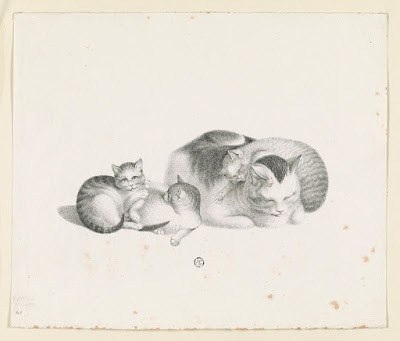 Mother cat and three kittens take a nap (lithograph, ca. 1820–1860).Lithographer: Joseph Brodtmann (1787–1862).Artist: Gottfried Mind (1768-1814). Via Library of Congress Prints and Photographs Division.
Mother cat and three kittens take a nap (lithograph, ca. 1820–1860).Lithographer: Joseph Brodtmann (1787–1862).Artist: Gottfried Mind (1768-1814). Via Library of Congress Prints and Photographs Division.
 Mother cat with three playful kittens (lithograph, ca. 1820–1860).Lithographer: Joseph Brodtmann (1787–1862).Artist: Gottfried Mind (1768-1814). Via Library of Congress Prints and Photographs Division.
Mother cat with three playful kittens (lithograph, ca. 1820–1860).Lithographer: Joseph Brodtmann (1787–1862).Artist: Gottfried Mind (1768-1814). Via Library of Congress Prints and Photographs Division. Mother cat and three kittens take a nap (lithograph, ca. 1820–1860).Lithographer: Joseph Brodtmann (1787–1862).Artist: Gottfried Mind (1768-1814). Via Library of Congress Prints and Photographs Division.
Mother cat and three kittens take a nap (lithograph, ca. 1820–1860).Lithographer: Joseph Brodtmann (1787–1862).Artist: Gottfried Mind (1768-1814). Via Library of Congress Prints and Photographs Division.
Published on June 17, 2015 02:30
June 15, 2015
Review of “Hiss and Tell,” the Latest Sunny & Shadow Mystery


Is it wrong to do wrong to do good?
If that question confused you, don’t worry: that just means you’re probably a nice, reasonable person who would not dream of coercing people into doing things for you. But I’m getting ahead of myself and jumping to the conclusion of the delightful latest Sunny & Shadow mystery from Claire Donally, Hiss and Tell, when we really should begin at the beginning.
The beginning brings us back to Kittery Harbor, Maine, Sunny Coolidge’s hometown. Sunny used to be a journalist in New York City, but now she works for a little adventure-travel company and looks after her dad. She also looks after a big gray tomcat named Shadow. She is accompanied in much of this by hunky boyfriend Will, who is a local constable currently running for sheriff.
Our heroine gets drawn into a soon-to-be mystery when the local paper sends her to cover a press conference about a high-profile society wedding set to take place at a nearby private compound. Later that night, a woman who was part of the wedding party get-together dies under suspicious circumstances. The deed must have been done by an insider, someone who is involved with the wedding.
This brings us to a lukewarm tip Sunny gets from her former boss/boyfriend about a blackmailer called the Taxman. This mysterious ne’er-do-well is said to be a “cross between Robin Hood and the Godfather.” But that’s all just some kind of urban legend—isn’t it?
Sunny next has the great good fortune to get herself embedded in the wedding party goings-on. Her mission: ostensibly to write upbeat blog posts about the get-together while also investigating the guests to identify a killer…and to play a little beer pong, too.
Oh, and Shadow goes along for the ride, unbeknownst to Sunny. But when Sunny ends up in real trouble, it’s just a good thing for her that the cat tagged along.
It’s a good thing for us, too, because Shadow’s appearances are some of the best parts of the book. From his perspective, people are “two-legs,” dogs are “biscuit eaters,” and a car is a “go fast.” Oh, and he speculates that Sunny is embarrassed about him seeing her naked because she has so little fur (makes sense to me).
And then there is one good old-fashioned, cat-chasing romp through a posh event, in a scene we would really love to see on a movie screen. After that, an overzealous security detail is out to get Shadow, Sunny is out to find Shadow without letting on that the trouble-making feline belongs to her, and Shadow is out to get back to Sunny—or not—and figure out what the heck is going on.
All that brings me back to my original question: Is it wrong to do wrong to do good?
You’ll have to discover the answer for yourself in the latest installment in this engaging, well-written series.


Published on June 15, 2015 02:30
June 12, 2015
Was Napoleon Bonaparte Afraid of Cats?
Miss Cuddlywumps examines the evidence for Napoleonic ailurophobia
 Was this man...
Was this man...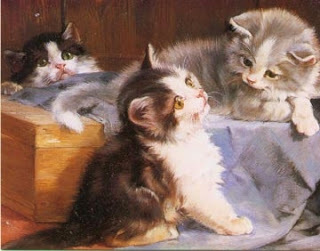 afraid of these?
afraid of these?Legend has it that Napoleon Bonaparte (1769–1821), who brought Europe the devastation of the Napoleonic Wars and brought pop psychology the so-called “Napoleon complex,” hated and was terrified of cats. Reportedly, just one cute little kitty could reduce the emperor to a mass of sweating, quivering jelly.
The evidence for ailurophobiaCarl Van Vechten in A Tiger in the House (1920) related what has become a rather famous tale of Napoleon. The story is prefaced with the phrase “according to popular legend,” which hardly indicates a solid historical source. Nevertheless, the story goes like this:
In 1809, during the second French occupation of Vienna, Napoleon was staying in the Palace of Schönbrunn. One night, an aide-de-camp on his way to bed passed by Napoleon’s room, from which he heard some unusual sounds and the emperor himself crying out for help. The aide rushed into the room, for surely his fearless leader was being subjected to some horrid sort of attack. What he found, though, was Napoleon, somewhat undressed, with sweat on his brow and a look of terror on his face as he repeatedly thrust his sword through the tapestry lining the walls.
What dangerous beast or assassin was Napoleon trying to skewer? Well, it was basically a domestic cat that was hiding rather innocently behind the tapestry.
Another story claims that a powerful woman bent Napoleon to her will simply by mentioning a cat at the appropriate moment in a conversation.
I know, it’s hard not to snicker (a short, fearsome general afraid of a kitty cat?), but She of Little Talent tells me that this particular terror is a real condition called ailurophobia. Symptoms include feelings of panic, terror, or dread in the presence of—or sometimes even when thinking of—cats. Treatment can include behavior therapy and anti-anxiety medication.
But is it true?That’s the reality. Now the question is, was Napoleon really an ailurophobe?
The two little stories we have seem to indicate that yes, indeed, Napoleon suffered from a deathly fear of felines. However, author Katharine MacDonogh has written that “no record exists of Napoleon either liking or hating cats” (p. 125). A “popular legend” is not a historical record.
We do know that Napoleon disliked dogs, or at least he wasn’t crazy about the beloved pugs belonging to Josephine, whom he married in 1796. The emperor would not let the pugs ride in the same carriage with them and would not let the dogs into the room he shared with Josephine. The pugs did have their very own maid, though, and when a journey was necessary, the “favorite pug of the day” rode in a second carriage with a servant to look after him (MacDonogh, p. 141). After Josephine’s most favorite pug, Fortuné, was killed by a cook’s dog, the lady’s lover (not Napoleon) gave her another pug as a replacement. Napoleon is said to have wished that the cook’s dog could repeat the favor it had done him with Fortuné (Williams, p. 105–6.).
The verdictI don’t think it’s too much of a leap to think that, if Napoleon didn’t like little pugs, he probably wasn’t crazy about cats either. Whether he was deathly afraid of cats remains unanswered. Stories about his supposed fear may have been fabricated by enemies simply trying to poke fun at him. The popular association of the feline with the feminine may have played a role here as well. The joke would have gone something like this:
Here we see the great emperor Napoleon, cowering before a mere womanly creature! Ha! Ha! Ha!
So was Napoleon actually an ailurophobe?
I want to say yes, but based on what we know, I have to rule that there is insufficient evidence, and the claim is therefore unproven.SourcesMacDonogh, Katharine. Reigning Cats and Dogs: A History of Pets at Court since the Renaissance. New York: St. Martin’s Press, 1999.
Van Vechten, Carl. Cats! The Cultural History. Kindle edition. Burslem Books, 2010. Originally published as The Tiger in the House, 1920.
Williams, Kate. Ambition and Desire: The Dangerous Life of Josephine Bonaparte. New York: Ballantine Books, 2014.
Picture credits
The Emperor Napoleon in his study at the Tuileries, c. 1812. By Jacques-Louis David (1748–1825). Public domain, via Wikimedia Commons.
Painting of three kittens by Julius Adam (1851–1913). Public domain, via Wikimedia Commons.
Published on June 12, 2015 02:30
June 10, 2015
Ship's Cat Learning to Climb into the Rigging
Wordless Wednesday
 In this photograph from the first half of the twentiethcentury, a seaman on the ship "Pommern" lures theship’s cat high above the deck.Photographer unknown.Photo from the National Maritime Museum, Greenwich,United Kingdom [Public domain], via Wikimedia Commons.
In this photograph from the first half of the twentiethcentury, a seaman on the ship "Pommern" lures theship’s cat high above the deck.Photographer unknown.Photo from the National Maritime Museum, Greenwich,United Kingdom [Public domain], via Wikimedia Commons.
 In this photograph from the first half of the twentiethcentury, a seaman on the ship "Pommern" lures theship’s cat high above the deck.Photographer unknown.Photo from the National Maritime Museum, Greenwich,United Kingdom [Public domain], via Wikimedia Commons.
In this photograph from the first half of the twentiethcentury, a seaman on the ship "Pommern" lures theship’s cat high above the deck.Photographer unknown.Photo from the National Maritime Museum, Greenwich,United Kingdom [Public domain], via Wikimedia Commons.
Published on June 10, 2015 02:30
Roby Sweet's Blog
- Roby Sweet's profile
- 7 followers
Roby Sweet isn't a Goodreads Author
(yet),
but they
do have a blog,
so here are some recent posts imported from
their feed.



